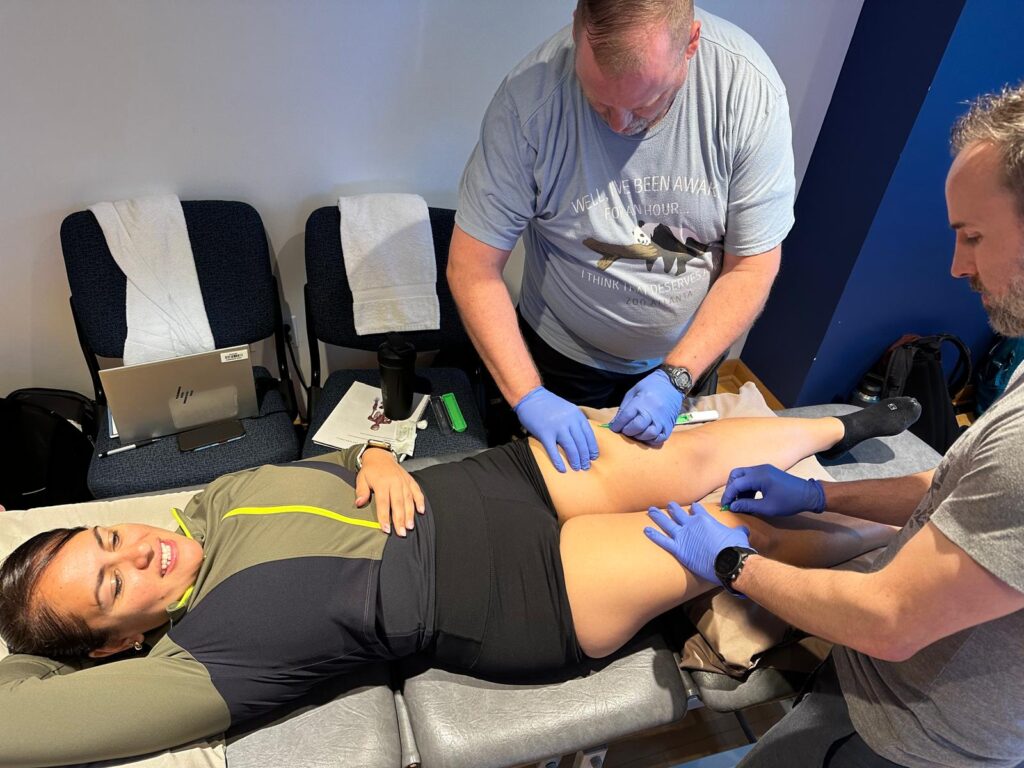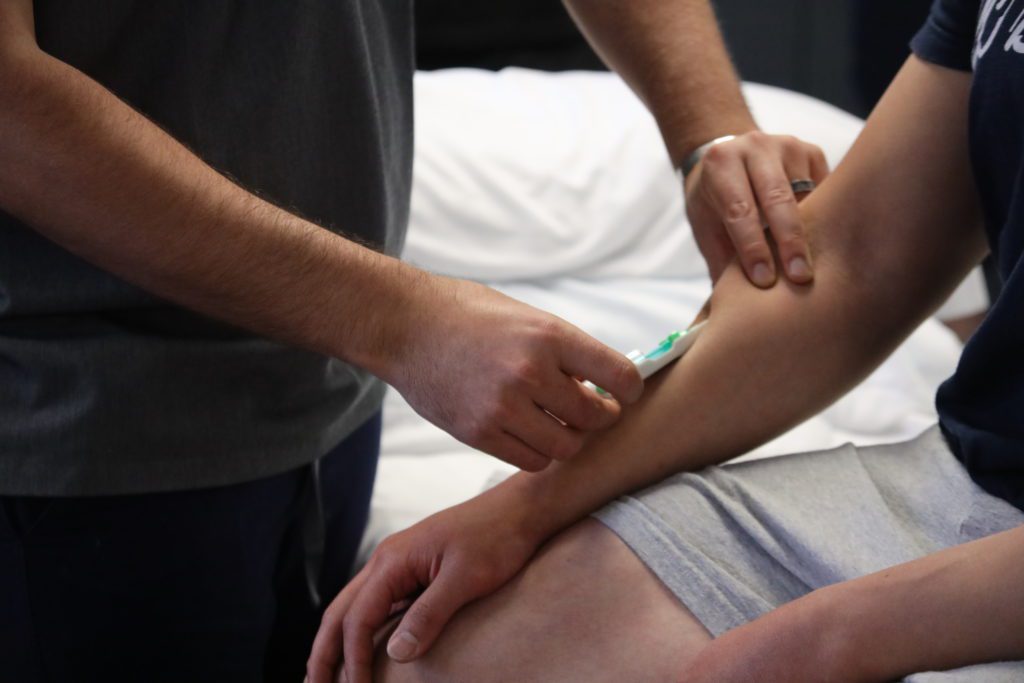Myopain Seminars is the exclusive provider of the Fu Subcutaneous Needling – American Version (FSN-AV) courses in the United States in close collaboration with Functional Fascia Therapeutics. The FSN-AV courses have been developed by Dr. Ryan Shepherd as an adaptation and expansion of the original Fu’s Subcutaneous Needling (FSN) approach by integrating insights and techniques from a range of other practitioners and scientists, such as Langevin, Myers, Fuller, Schleip, and Stecco, among others [1-5].
The approach was originally developed in 1996 in Nanjing, China. The name FSN, or Fu Zhen (浮针 in simplified Chinese or 浮針 in Traditional Chinese), is a fitting term, as “Fu” is not only the surname of the inventor but in Chinese, ‘Fu, 浮’ also means “floating” or “superficial,” while the word “Zhen” means acupuncture or needling. In English-language papers, FSN is sometimes referred to as floating acupuncture [6], Fu’s acupuncture [7], Fu needling [8], and floating needling [9]; however, the term “superficial” captures the approach more accurately [10]. With FSN, the needle can be considered a floating needle as it abstains completely from muscle and stays strictly within the subcutaneous tissue or superficial fascia, floating between the dermis and the muscle.
The FSN-AV approach is a systematic approach from assessment to treatment. It incorporates the dynamics of fascia to identify areas of dysfunction in the body and address structural imbalances akin to myofascial pain and muscle dysfunction by direct fascial manipulation with a specially designed needle. During the past few months, several new studies and case reports of FSN have been published.
Although FSN started as a strictly empirical approach, a growing body of scientific evidence supports using it in the clinic [11]. For example, Bao compared FSN, acupuncture, and physical therapy for the treatment of shoulder pain and found significant differences between groups and improvement in all post-treatment measures in a retrospective pilot study, concluding FSN can be an effective rehabilitation intervention for improving shoulder pain and shoulder range of motion [12]. A randomized controlled parallel study of FSN vs. massage therapy of 60 patients with chronic, non-specific low back pain concluded more significant improvement in all prognostic indicators for FSN vs. massage immediately after treatment and 12 months later [13]. A 2022 study, also of 60 subjects aged 26-70m with lateral epicondylalgia, confirmed that FSN is a safe and effective treatment option for lateral epicondylalgia with immediate pain relief, an increase in pressure pain threshold, pain-free grip, and a decrease in muscle tissue hardness after just one treatment [14]. A 2022 FSN study conducted on rats with sciatica found positive changes to skeletal muscle mitochondrial ultrastructure and citrate synthase activity and a significant improvement in pain threshold [15].
Molecular Mechanisms
Fu Subcutaneous Needling is commonly used to treat painful conditions, but its molecular mechanisms are unknown. Huang and colleagues suggested that it is conceivable that the swaying movement of FSN within the superficial fascia may be able to elicit a piezoelectric effect, improving cell ion channels, diffusing and transmitting the effect to distant muscles, and eliciting an immediate change in tissue plasticity [16]. A recent comprehensive study aimed to observe the therapeutic effect of FSN on hind limb pain in an animal model of chronic compressive injury (CCI)-induced sciatica, which is a type of peripheral neuropathy affecting one or more lower extremity nerves [17]. The researchers attempted to shed some light on the possible mechanisms of FSN regulation in patients with peripheral nerve injuries using several assessment methods. The results were very encouraging as FSN significantly improved sciatic nerve pain assessed by paw withdrawal thresholds, sciatic functional index scores, and compound muscle action potential amplitude tests [17]. The FSN therapy reduced axonal swelling, abnormal myelin sheaths, and the number of organelle vacuoles in CCI-induced animals, as evidenced by transmission electron microscopy images of sciatic nerve tissue. Furthermore, RNA sequencing and gene set enrichment analysis showed significantly reduced inflammatory pathways, neurotransmitters, and endoplasmic reticulum stress pathways and increased nerve regeneration factors in the FSN+CCI group compared with the CCI group. Lastly, the dorsal root ganglia and sciatic nerve showed similar results with immunohistochemistry, immunoblotting, and enzyme-linked immunosorbent assays [17]. The researchers concluded that FSN may be able to effectively reduce peripheral neuropathic pain by regulating inflammation and endoplasmic reticulum stress, thereby determining its beneficial application in patients with peripheral nerve injuries [17].
Osteoarthritis
A prospective randomized trial of 62 patients with knee osteoarthritis, who were randomized into either a group receiving electro-acupuncture or a group receiving FSN, showed significantly greater improvements in the FSN subjects in claudication, joint stability, swelling, pain, and ROM after treatment [18]. After three months, the FSN group maintained better scores of claudication, joint stability, swelling, walking upstairs, squatting, pain, ROM, and equilibrium function (compared to the electro-acupuncture group [18].
Bell’s Palsy
Fang and colleagues reported a case of a 29-year-old male diagnosed with Bell’s Palsy [19]. The patient had been treated with acupuncture, which had helped with his pre-existing 10-year history of facial palsy, but it did not relieve the current symptoms. The current symptoms, which started after the patient was exposed to severe cold temperatures, included
- right-sided facial muscle stiffness
- ptosis of the labial angle, failure to frown the right eyebrow
- a 2 mm exposure of the eyeball when gently closing the eyes
- air leaking when bulging the cheeks
- drooling when brushing the teeth and gargling
- food retainment in the cheek when eating.
The clinician treated the right frontalis, orbicularis oculi, zygomatic, masseter muscle, orbicularis oris, scalene, brachioradialis, and perinasal muscles, and the bilateral upper trapezius muscle once every two days, three times a week for four consecutive weeks [19]. The FSN treatments were complimented by 15 minutes of infrared treatments. Progress was objectively evaluated by dynamically measuring superficial blood perfusion changes with Laser Speckle Contrast Imaging (LSCI). According to the treating physician and the patient, FSN effectively treated acute Bell’s palsy and restored facial blood perfusion [19].
Phantom Limb Pain
Huang and colleagues presented a case of a 64-year-old male who suffered from phantom limb pain following an above-knee amputation ten years earlier [20]. The patient received daily treatments with FSN on four consecutive days directed at the abdominal oblique, the erector spinae, the  iliopsoas, and the gluteus medius muscles. The patient had a 70% reduction in pain and could reduce his pain medications. The researchers checked in with the patient three years later, and he confirmed that he no longer suffered from phantom limb pain [20]. Encouraged by the results, the researchers conducted a systematic review of nine articles. They found that patients with a pain reduction rate below 50% required an average of 4.3 sessions and 21.8 days of treatment, while patients with a reduction rate exceeding 50% needed an average of 10.8 sessions and 9.2 weeks of treatment. Even though the mechanisms for pain relief remain unknown, adding FSN to the treatment regime can be beneficial, especially when more conventional methods have failed [20].
iliopsoas, and the gluteus medius muscles. The patient had a 70% reduction in pain and could reduce his pain medications. The researchers checked in with the patient three years later, and he confirmed that he no longer suffered from phantom limb pain [20]. Encouraged by the results, the researchers conducted a systematic review of nine articles. They found that patients with a pain reduction rate below 50% required an average of 4.3 sessions and 21.8 days of treatment, while patients with a reduction rate exceeding 50% needed an average of 10.8 sessions and 9.2 weeks of treatment. Even though the mechanisms for pain relief remain unknown, adding FSN to the treatment regime can be beneficial, especially when more conventional methods have failed [20].
Restless Leg Syndrome
Qu and colleagues shared a report of the successful treatment of a 67-year-old patient suffering from severe right-sided restless leg syndrome, nocturnal discomfort, uncontrollable movements of the right leg, and a burning sensation [21]. The International Restless Legs Syndrome Study Group rating scale (IRLS) score was 26 out of a possible 40. The patient was anxious and had disabling insomnia. The treating clinician focused on needling and manipulating the lower third of the right musculus tibialis anterior, the lower border of the right rectus abdominis, the right gastrocnemius tendon and the muscle belly, the lower third of the right tensor fascia lata, the lower border of the right musculus vastus lateralis, the lower border of the vastus lateralis muscles, and the lower border of the right erector spinae muscle. After six weeks, the patient had few remaining symptoms and improved sleep quality. The researchers mentioned a significant reduction in tenderness of multiple trigger points in the leg.
Postsurgical Gastroparesis Syndrome
Liang and colleagues used FSN to treat a 69-year-old male patient suffering from postsurgical gastroparesis syndrome with complaints of progressive nausea, vomiting and stomach fullness, with a bloating abdomen ten days after laparoscopic radical gastrectomy for gastric cancer [22]. Conventional treatments, including gastrointestinal decompression, gastric acid suppression therapy, and intravenous nutritional support, had failed. However, FSN administered for just three days resolved all the symptoms and reduced the gastric drainage volume by 1,000 ml/day to 10 ml/day with normal peristalsis of the remnant stomach, as evidenced by upper gastrointestinal angiography [22].
Guillain–Barré Syndrome
Fu and colleagues reported about a 28-year-old female diagnosed with Guillain–Barré syndrome with orthostatic hypotension, lower limb sensory nerve damage, and evidence of a protein–leukocyte separation in her cerebrospinal fluid [23]. After two months of conventional treatments with immunotherapy and hormone therapy, the orthostatic hypotension remained unchanged; however, after only three FSN treatments, the hypotension improved significantly with a much smaller drop in systolic blood pressure in the standing position. At a 3-month follow-up, the patient was symptom-free and could stand and walk for short distances [23].
Post Low Back Surgery
A study published in the Journal of Pain Research demonstrated that patients who had spinal surgery for degenerative disorders benefitted greatly from Fu Subcutaneous Needling [24]. In this single-blinded randomized study, patients were divided into two groups receiving FSN or a superficial acupuncture needle. The acupuncture needle did not enter the subcutaneous layer and was not being moved. The needle was left in place for eight hours to compare the control and FSN treatments. Unlike in the US, in China, FSN needles are left in place subcutaneously for eight or more hours.
The primary outcomes were pain and functional disability, assessed with a variety of tools, including the Taiwanese version of the Brief Pain Inventory (BPI-T) Short Form, the Oswestry Disability Index (ODI), the use of pethidine, the presence of inflammatory markers (such as serum concentrations of C-reactive protein (CRP), interleukin (IL)-1β, IL-2, IL-6, and tumor necrosis factor (TNF)-α), and the hardness of muscles (measured with a tissue hardness meter).

The FSN group had significantly lower pain intensity than the control group at 1, 24, 48, and 72 hours after surgery. Pain interference was also lower in the FSN group and the FSN group exhibited less muscle hardness in the latissimus dorsi, gluteus maximus, and the L3 paraspinal muscle. However, the FSN and control groups had no significant differences in serum CRP, IL-1β, IL-2, IL-6, and TNF-α levels. Based on this small study, the authors concluded that FSN treatment can reduce postoperative pain in patients receiving surgery for degenerative spinal disorders. Larger sample sizes and multicenter clinical trials are required to verify these findings
Axonal Regeneration and Remyelination
A 2024 study suggested that FSN may reduce peripheral neuropathic pain by regulating inflammation and endoplasmic reticulum stress [25]. Patients with osteoarthritis and peripheral neuropathic pain significantly recovered after 1 to 2 weeks of FSN treatment as assessed by a Visual Analog Scale, the Western Ontario and McMaster Universities Osteoarthritis Index, the Lequesne index, walking speed, and passive range of motion. Next, the authors developed an animal model to study the effects of FSN on chronic constriction injury (CCI). Fu Subcutaneous Needling significantly improved sciatic nerve pain measured by paw withdrawal thresholds, sciatic functional index scores, and compound muscle action potential amplitude tests. The authors reported that “transmission electron microscopy images of sciatic nerve tissue showed that FSN effectively reduced axonal swelling, abnormal myelin sheaths, and the number of organelle vacuoles in CCI-induced animals.” Furthermore, they demonstrated significantly reduced inflammatory pathways, neurotransmitters, and endoplasmic reticulum stress pathways and increased nerve regeneration factors in the FSN+CCI group, compared with that in the CCI group using RNA sequencing and gene set enrichment analysis. Lastly, immunohistochemistry, immunoblotting, and enzyme-linked immunosorbent assay showed similar results in the dorsal root ganglia and sciatic nerve [25].
Summary
Fu Subcutaneous Needling is a new and emerging needling approach [11]. Since its initial introduction in 1996 [11], several recent scientific studies have confirmed its efficacy [17-25]. Graduates of the Myopain Seminars dry needling programs or of any other nationally accepted dry needling course program are eligible to attend this course.
The Obvious Choice for Dry Needling Education
Fu Subcutaneous Needling – American Version

The Fu Subcutaneous Needling – American Version Course (FSN) is designed to provide students with a comprehensive introduction to fascial needling by areas of the body utilizing ROM assessment, treatment skills, and techniques specific to the field of myofascial pain and muscle dysfunction.
References
- Dischiavi, S.L., et al., Biotensegrity and myofascial chains: A global approach to an integrated kinetic chain. Medical Hypotheses, 2018. 110: p. 90-96. https://doi.org/10.1016/j.mehy.2017.11.008
- Langevin, H.M., et al., Dynamic fibroblast cytoskeletal response to subcutaneous tissue stretch ex vivo and in vivo. Am J Physiol Cell Physiol, 2005. 288(3): p. C747-56. https://doi.org/10.1152/ajpcell.00420.2004
- Myers, T.W., Anatomy trains e-book: myofascial meridians for manual and movement therapists. 2013: Elsevier Health Sciences.
- Schleip, R., Fascial plasticity – a new neurobiological explanation: Part 1. J Bodyw Mov Ther, 2003. 7(1): p. 11-19. https://doi.org/10.1016/S1360-8592(02)00067-0
- Stecco, A., et al., Fascial Disorders: Implications for Treatment. PM R, 2016. 8(2): p. 161-8. https://doi.org/10.1016/j.pmrj.2015.06.006
- Huang, Y., et al., Introduction to floating acupuncture: clinical study on the treatment of lateral epicondylitis. J Acupunct, 1998. 26: p. 27-31.
- Chang-Chun, Z., An investigation on Fu’s acupunture treat lumbago. Journal of Clinical Acupuncture and Moxibustion, 2004.
- Xia, D. and Y. Huang, Combination of Fu needling with electric acupuncture for tennis elbow. Di Yi Jun Yi Da Xue Xue Bao, 2004 24(1328-9).
- Fu, Z. and Y. Huang, Floating needling. Int J Clin Acupunct, 1999. 10: p. 51-52.
- Fu, Z.-H. and J.-G. Xu, A brief introduction to Fu’s subcutaneous needling. Pain Clinical Updates, 2005. 17(3): p. 343-348.
- Fu, Z. and L.-W. Chou, Fu’s subcutaneous needling, in Trigger point dry needling; an evidenced and clinical-based approach, J. Dommerholt and C. Fernández De Las Peñas, Editors. 2018, Churchill Livingstone: Edinburgh.
- Bao, X., et al., Treatment effect and mechanism of Fu’s subcutaneous needling among patients with shoulder pain: A retrospective pilot study. Anat Rec (Hoboken), 2021. 304(11): p. 2552-2558.
- Ma, K.L., et al., Fu’s subcutaneous needling versus massage for chronic non-specific low-back pain: a randomized controlled clinical trial. Ann Palliat Med, 2021. 10(11): p. 11785-11797.
- Huang, C.H., et al., Efficacy of Fu’s Subcutaneous Needling on Myofascial Trigger Points for Lateral Epicondylalgia: A Randomized Control Trial. Evid Based Complement Alternat Med, 2022. 2022: p. 5951327.
- Li, Y., et al., Effects of Fu’s subcutaneous needling on mitochondrial structure and function in rats with sciatica. Mol Pain, 2022. 18: p. 17448069221108717.
- Huang, H., et al., Fu’s subcutaneous needling for subcutaneous adhesions and scar hyperplasia in the neck region: A case report. Medicine (Baltimore), 2020. 99(29): p. e21103.
- Chiu, P.-E., et al., Fu’s subcutaneous needling promotes axonal regeneration and remyelination by inhibiting inflammation and endoplasmic reticulum stress. Translational Research, 2024.
- Mou, J., et al., The effect of Fu’s subcutaneous needling in treating knee osteoarthritis patients: A randomized controlled trial. EXPLORE, 2024. 20(4): p. 562-571.
- Fang, W.-j., et al., Fu’s subcutaneous needling in treatment of acute Bell’s palsy observed by laser speckle contrast imaging: A case report: 激光散斑成像技术观察浮针治疗急性贝尔面瘫案:病例报道. World Journal of Acupuncture – Moxibustion, 2024. 34(1): p. 67-
- Huang, H., et al., Ten-year phantom limb pain with only four sessions of Fu’s subcutaneous needling: A case report and systematic review. EXPLORE, 2024. 20(4): p. 513-519.
- Qu, K., K. Xue, and Y. Ma, Treatment of primary restless legs syndrome with Fu’s subcutaneous needling: A case report. EXPLORE, 2024. 20(2): p. 253-255.
- Liang, Y., et al., Treatment of postsurgical gastroparesis syndrome with Fu’s subcutaneous needling: A case report. EXPLORE, 2023. 19(6): p. 827-831.
- Fu, Z., et al., Fu’s subcutaneous needling for orthostatic hypotension due to Guillain-Barré syndrome: A case report. Journal of Traditional Chinese Medical Sciences, 2022. 9(4): p. 454-457.
- Wu, C. Y., Chou, L. W., Huang, S. W., Liao, W. L., Chang, S. M., Lee, H. C., Chiu, C. D., Tang, C. H., & Hsieh, C. L. (2024). Effects of Fu’s Subcutaneous Needling on Postoperative Pain in Patients Receiving Surgery for Degenerative Lumbar Spinal Disorders: A Single-Blind, Randomized Controlled Trial. J Pain Res, 17, 2325-2339. https://doi.org/10.2147/JPR.S465417
- Chiu, P.-E., Fu, Z., Tsai, Y.-C., Tsai, C.-Y., Hsu, W.-J., Chou, L.-W., & Lai, D.-W. (2024). Fu’s subcutaneous needling promotes axonal regeneration and remyelination by inhibiting inflammation and endoplasmic reticulum stress. Translational Research, 273, 46-57. https://doi.org/https://doi.org/10.1016/j.trsl.2024.06.005

